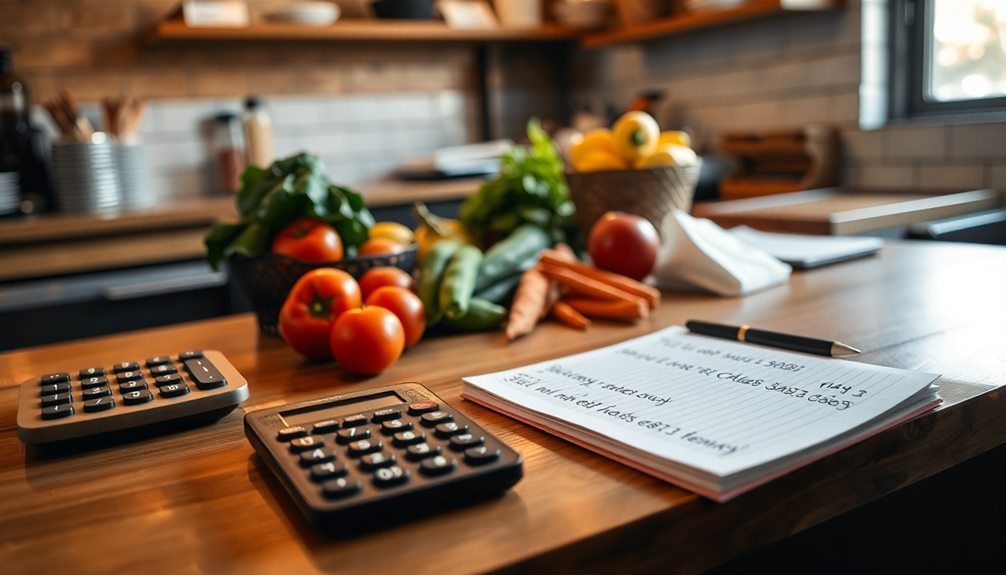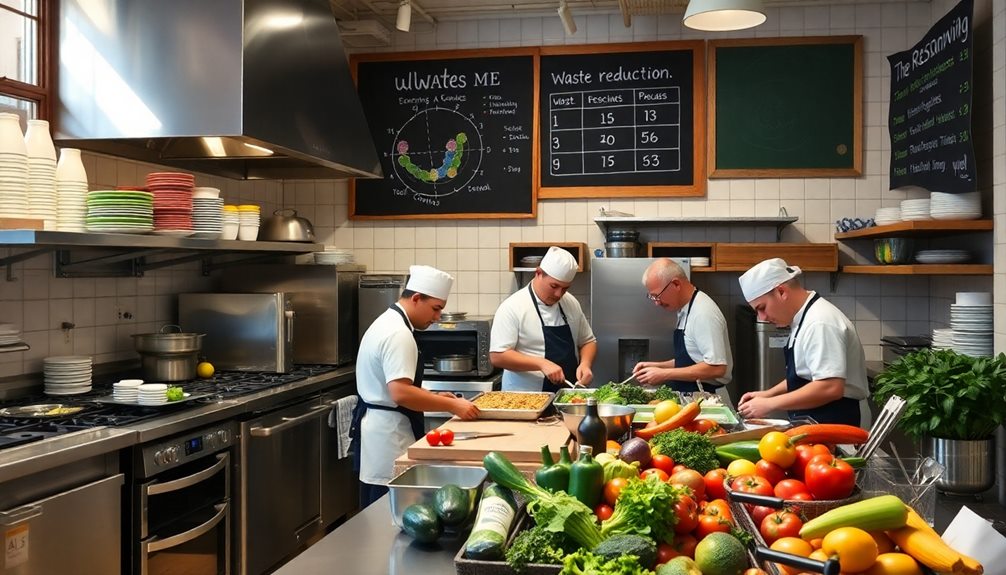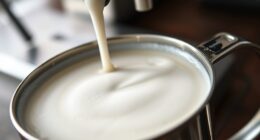To calculate your food cost percentage, start by gathering your total Cost of Goods Sold (CoGS) and total revenue. Use the formula: (CoGS / Total Revenue) x 100. It's helpful to determine CoGS with this formula: (Beginning Inventory + Purchases – Ending Inventory). Aim for a food cost percentage between 25% and 40%, ideally around 30%. Regular monitoring will help you identify unprofitable menu items and adjust prices accordingly. This process keeps your financials in check and boosts profitability. Stick around, and you'll uncover more valuable insights for enhancing your restaurant's cost management.
Key Takeaways
- Calculate Food Cost Percentage using the formula: (Total Cost of Goods Sold / Total Revenue) x 100.
- Determine Cost of Goods Sold by subtracting Ending Inventory from the sum of Beginning Inventory and Purchases.
- Aim for an ideal food cost percentage between 25% and 40% for optimal profitability.
- Regularly monitor food costs to identify trends and adjust menu pricing accordingly.
- Utilize technology like POS systems for accurate, real-time food cost calculations and inventory management.
Understanding Food Cost Percentage
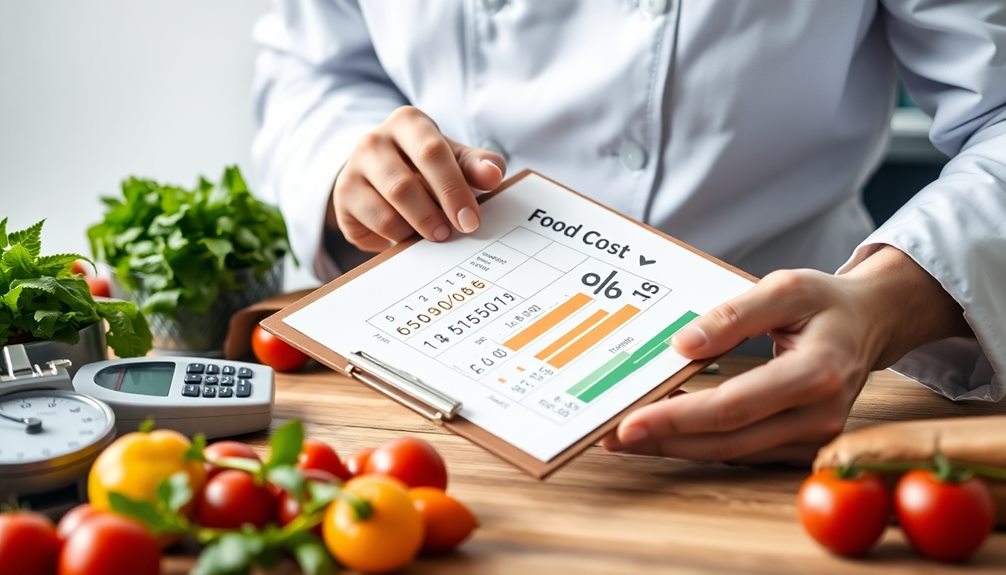
Understanding food cost percentage is vital for running a successful restaurant. This percentage represents the ratio of total food costs to total revenue, helping you see how much of your revenue goes toward food supplies.
To calculate food cost percentage, you'll use the formula: (Total Cost of Goods Sold / Total Revenue) x 100. Monitoring this percentage regularly is important for maintaining your restaurant's financial health.
An ideal food cost percentage typically ranges from 25% to 40%, with many aiming for around 30% to guarantee profitability.
If your food cost percentage is too high, it might indicate unprofitable menu items, prompting a reevaluation of your menu pricing strategies and ingredient sourcing.
Steps to Calculate Food Cost
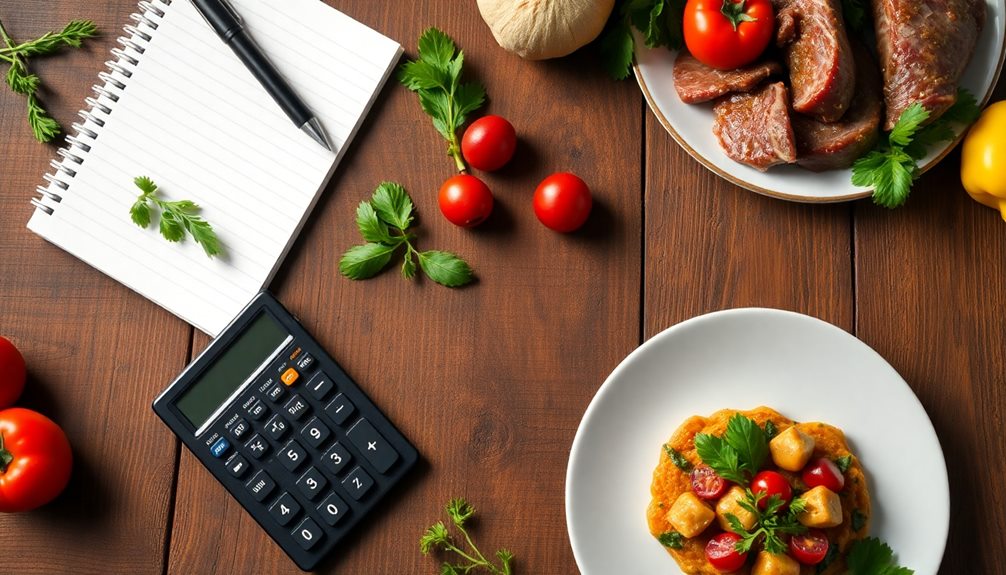
To calculate food cost, you first need to gather all the necessary data, including your total cost of goods sold and total revenue.
Once you have that information, you can apply the calculation formula to determine your food cost percentage.
This process helps you gain insights into your restaurant's profitability and manage costs effectively.
Gather Necessary Data
Start by gathering all necessary data to calculate your food cost percentage effectively. First, determine your Cost of Goods Sold (CoGS) using the formula: (Beginning Inventory + Purchases – Ending Inventory). This gives you the total food costs incurred during a specific period.
Next, collect total revenue data for the same timeframe, which includes all sales from food and beverage items.
Once you have this information, you can begin to calculate food cost percentage. Use the food cost percentage formula: (CoGS / Total Revenue) x 100. This will yield the overall food cost percentage for your restaurant.
For a more detailed analysis, calculate the total cost of ingredients used in each menu item. Divide this figure by the selling price of the dish and multiply by 100 to find the food cost percentage per dish.
To guarantee accuracy, make regular inventory checks and maintain precise record-keeping. This practice is essential for effective calculations and financial management.
Apply Calculation Formula
Now that you've gathered the necessary data, it's time to calculate your food cost percentage. Start by determining your Cost of Goods Sold (COGS) using the formula: (Beginning Inventory + Purchases – Ending Inventory). This calculation will give you the total food costs for the specific period.
Next, you'll need your Total Revenue, which is the income generated from food sales during that same timeframe. This figure is essential as it allows for an accurate comparison with your costs.
Now, apply the food cost percentage formula: (Cost of Goods Sold / Total Revenue) x 100. Simply divide the COGS by the Total Revenue and multiply by 100 to express the result as a percentage. This percentage indicates how much of your revenue is consumed by restaurant food costs.
Regularly calculating your food cost percentage is critical for evaluating profitability. Aim for a target range of 25% to 40%.
If your percentage falls outside this range, consider making pricing adjustments or reducing expenses to enhance your bottom line. By keeping a close eye on these metrics, you can guarantee your restaurant remains financially healthy.
Importance of Accurate Calculations
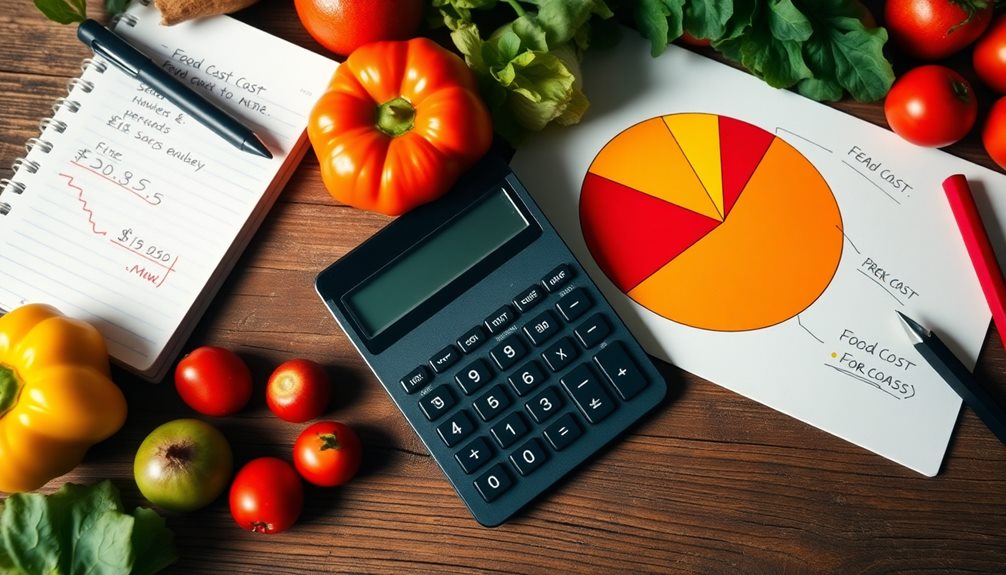
Accurate calculations of food cost percentage are essential for maintaining your restaurant's financial stability.
They help you develop informed pricing strategies that respond to changing ingredient costs while providing insights to improve profitability.
Financial Stability Assurance
When you guarantee precise calculations of food cost percentages, you're not just crunching numbers; you're safeguarding your restaurant's financial stability. Accurate calculations can prevent significant annual losses, which could exceed $100,000 for a restaurant serving 350 customers daily. Regularly monitoring food costs helps you identify trends and make timely adjustments, ensuring your pricing strategies align with your financial goals.
Establishing an ideal food cost percentage, typically between 25% to 40%, allows you to benchmark performance against industry standards and assess profitability effectively. By utilizing technology like a restaurant POS system, you can enhance the accuracy of your calculations, drastically reducing manual errors.
| Aspect | Importance | Tools/Methods |
|---|---|---|
| Accurate Calculations | Prevent financial losses | Restaurant POS System |
| Monitoring Food Costs | Identify trends & deviations | Regular audits |
| Ideal Food Cost % | Benchmark performance | Industry standards |
| Menu Design | Price high-cost items correctly | Menu analysis tools |
| Pricing Strategies | Maintain overall profitability | Dynamic pricing analysis |
Informed Pricing Strategies
Understanding food cost percentages directly influences how you set your menu prices. If you can accurately calculate food cost, you'll not only align your pricing strategies with industry standards but also safeguard your profit margins. The ideal food cost percentage typically ranges from 25% to 40%, so knowing this benchmark is essential.
Regularly calculating food costs per dish allows you to identify which items are profitable and which aren't, guiding necessary price adjustments. By monitoring food cost percentages, you can make informed decisions about inventory costs, ensuring you maintain profitability despite fluctuating ingredient prices.
Utilizing technology, like restaurant POS systems, streamlines this process, providing real-time data that supports your pricing decisions. This proactive approach to monitoring food cost not only enhances your restaurant financial stability but also empowers you to negotiate better with vendors and source ingredients more effectively.
Informed pricing strategies are integral to your restaurant's success, as even a small miscalculation can lead to significant annual losses. By staying vigilant and calculating food costs regularly, you can position your restaurant for sustained profitability.
Profitability Improvement Insights
Calculating food cost percentages accurately is essential for any restaurant aiming to boost profitability. By conducting a precise food cost percentage calculation, you can identify which menu items are profitable and which aren't.
Ideally, you should target a range between 25% and 40%. Regularly tracking these percentages helps you avoid significant revenue losses; even minor pricing errors can lead to $100,000 in losses annually for a restaurant serving 350 customers daily.
Understanding how to calculate food cost percentages allows you to develop informed menu pricing strategies that align with ingredient costs while still attracting customers.
Accurate calculations also enhance supplier negotiations and inventory management, which are vital for improving operational efficiency and reducing costs.
Continuously monitoring your overall food cost percentage enables you to make timely adjustments to your menu and pricing. This proactive approach not only enhances your profitability but also contributes to your restaurant's financial stability.
Strategies for Lowering Food Costs
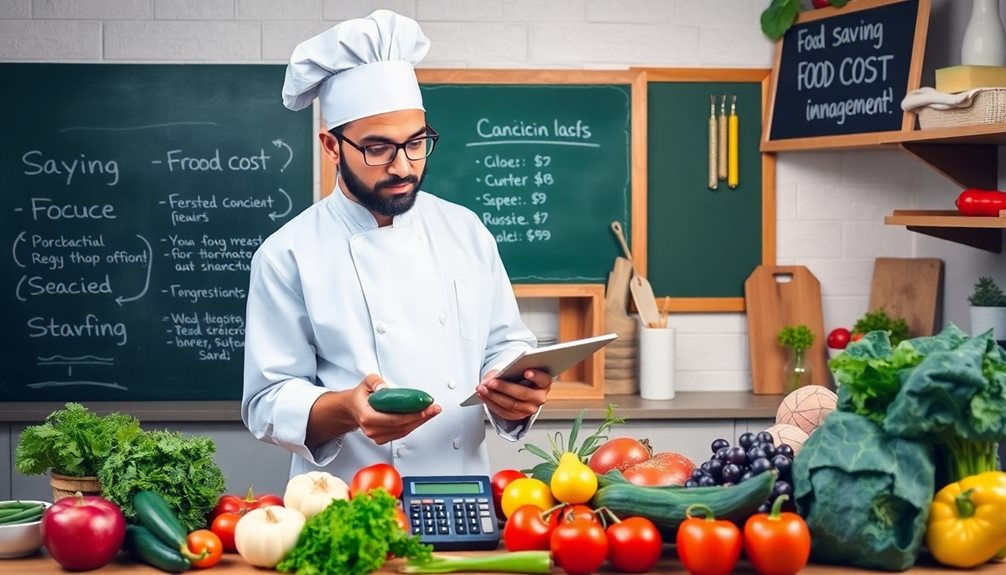
Lowering food costs requires a strategic approach that can greatly impact your bottom line. Start by implementing menu engineering to analyze food cost percentages and adjust your menu items accordingly.
Focus on dishes that share ingredients to minimize waste and streamline your inventory. You should also negotiate better pricing with suppliers or consider joining group purchasing organizations to drive down ingredient costs.
Additionally, consider the importance of maintaining good indoor air quality in your establishment, as it can enhance the overall dining experience and customer satisfaction, while ensuring heat pumps filter and circulate indoor air.
Another effective strategy is portion control. By standardizing serving sizes, you can reduce food waste and lower food costs without sacrificing customer satisfaction.
Make it a habit to regularly track food costs and analyze trends, so you can quickly identify fluctuations in ingredient pricing and adjust your menu prices as needed.
Additionally, utilizing seasonal ingredients can enhance your menu appeal while lowering expenses. These items are often more abundant and competitively priced during their peak availability.
Don't forget to use a food cost calculator to keep everything in check. By implementing these strategies, you can successfully lower food costs and improve your overall profitability.
Utilizing Technology for Cost Management
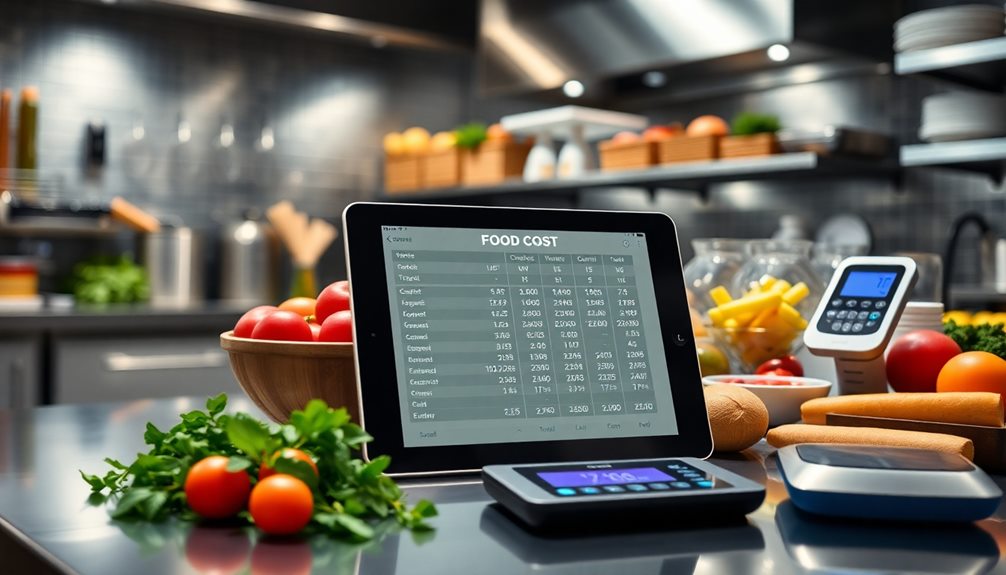
Managing food costs effectively can be greatly boosted by leveraging technology. By investing in a restaurant POS system, you can automate food cost calculations and gain real-time insights into your inventory and sales data. This allows you to make informed decisions that impact your bottom line.
Utilizing recipe costing tools is another smart move; these tools help you determine the exact cost per dish, enabling you to adjust pricing strategies accordingly.
Additionally, technology-driven inventory management systems send alerts for ingredient shortages or overstock, minimizing waste and optimizing purchasing decisions.
Don't overlook the power of integrated accounting software, which streamlines tracking food costs and enhances accurate budgeting and forecasting.
Analytics platforms can analyze historical food cost data, helping you identify trends and adapt your menu and pricing in response to market changes.
Analyzing Food Cost Implications
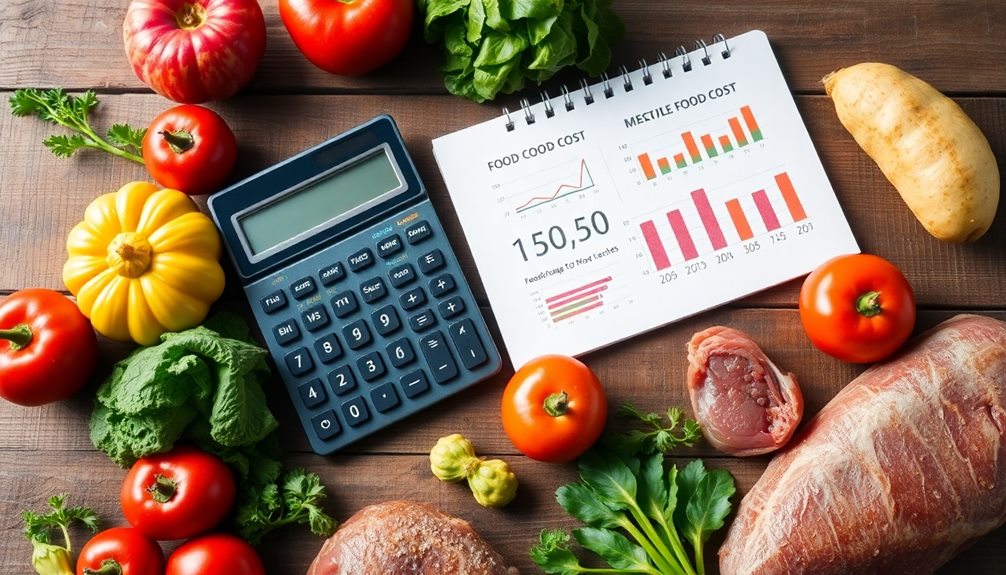
Understanding food cost implications is essential for ensuring your restaurant's financial health. As a restaurant owner, monitoring your food cost percentage is critical; if it exceeds industry benchmarks of 28-35%, it might signal potential financial instability.
Regular food cost analysis helps you identify unprofitable menu items, allowing for strategic adjustments that enhance profitability. By evaluating food cost percentages, you can set competitive pricing strategies that entice customers while covering your costs.
Keep in mind that seasonal fluctuations in ingredient prices can greatly impact your food cost percentages. Consequently, it's imperative to stay updated on these changes for effective budgeting and financial planning.
Utilizing technology like restaurant POS systems gives you access to real-time data on inventory value, sales, and cost trends. This information enables you to make informed decisions about supplier negotiations and promotional strategies.
Frequently Asked Questions
What Is the Formula to Calculate the Food Cost Percentage?
To find the food cost percentage, you divide the cost of goods sold by total revenue and multiply by 100. This calculation helps you understand the relationship between your food costs and overall sales.
How Do You Calculate 30% Food Cost?
You'd think calculating a 30% food cost is complicated, right? It's not! Just determine your revenue, multiply by 0.3, and voilà! Now, keep those costs in check to boost your profits effortlessly.
How Do You Calculate Cost Percentage?
To calculate cost percentage, you divide the total cost by total revenue and multiply by 100. Regularly reviewing these figures helps you make informed decisions on pricing and expenses to enhance profitability.
How Do I Calculate Food Cost Percentage in Excel?
To tally totals in Excel, you've got to input your costs and revenues. Use formulas to find the food cost percentage, ensuring you track trends for better budgeting and balance in your business.
Conclusion
In the world of food service, understanding your food cost percentage is like steering a ship through stormy waters. By accurately calculating your costs and implementing smart strategies, you can guide your business toward profitability. Embrace technology to help you chart your course, and don't underestimate the importance of regular analysis. When you manage your food costs effectively, you'll not only stay afloat but thrive in a competitive market. Keep your eye on the horizon for continued success!
